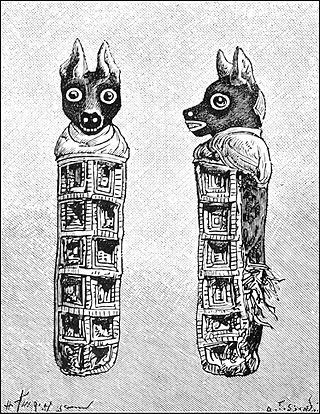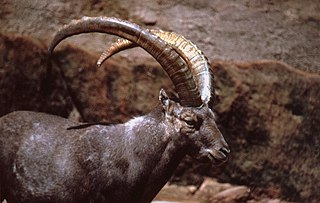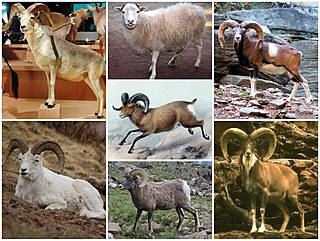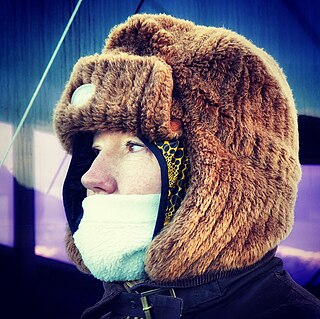
Zooarchaeology, also known as faunal analysis, is a branch of archaeology that studies remains of animals from archaeological sites. Faunal remains are the items left behind when an animal dies. These include bones, shells, hair, chitin, scales, hides, proteins and DNA. Of these items, bones and shells are the ones that occur most frequently at archaeological sites where faunal remains can be found. Most of the time, a majority of these faunal remains do not survive. They often decompose or break because of various circumstances. This can cause difficulties in identifying the remains and interpreting their significance.

An ibex is any of several species of wild goat , distinguished by the male's large recurved horns, which are transversely ridged in front. Ibex are found in Eurasia, North Africa and East Africa. The name ibex comes from Latin, borrowed from Iberian or Aquitanian, akin to Old Spanish bezerro "bull", modern Spanish becerro "yearling". Ranging in height from 70 to 110 centimetres (27–43 in) and weighing 90 to 120 kilograms (200–270 lb), ibex can live 20 years. Two closely related varieties of goats found in the wild are not usually called ibex: the markhor and the feral goat.

The mouflon is a wild sheep native to Cyprus, the Caspian region from eastern Turkey, Armenia, Azerbaijan, and Iran. It is thought to be the ancestor of all modern domestic sheep breeds.

Capra is a genus of mammals, the goats, composed of up to nine species, including the markhor and many species known as ibexes. The domestic goat is a domesticated species derived from the wild goat. Evidence of goat domestication dates back more than 8,500 years.

The wild goat is a wild goat species, inhabiting forests, shrublands and rocky areas ranging from Turkey and the Caucasus in the west to Turkmenistan, Afghanistan and Pakistan in the east. It has been listed as near threatened on the IUCN Red List and is threatened by destruction and degradation of habitat.
The term bioarchaeology has been attributed to British archaeologist Grahame Clark who, in 1972, defined it as the study of animal and human bones from archaeological sites. Redefined in 1977 by Jane Buikstra, bioarchaeology in the United States now refers to the scientific study of human remains from archaeological sites, a discipline known in other countries as osteoarchaeology, osteology or palaeo-osteology. Compared to bioarchaeology, osteoarchaeology is the scientific study that solely focus on the human skeleton. The human skeleton is used to tell us about health, lifestyle, diet, mortality and physique of the past. Furthermore, palaeo-osteology is simple the study of ancient bones.

The argali, also known as the mountain sheep, is a wild sheep that roams the highlands of western East Asia, the Himalayas, Tibet, and the Altai Mountains.

Ovis is a genus of mammals, part of the Caprinae subfamily of the ruminant family Bovidae. Its seven highly sociable species are known as sheep or ovines. Domestic sheep are members of the genus, and are thought to be descended from the wild mouflon of central and southwest Asia.

Ganj Dareh is a Neolithic settlement in western Iran. It is located in the Harsin County in east of Kermanshah Province, in the central Zagros Mountains.

The goat or domestic goat is a domesticated species of goat-antelope typically kept as livestock. It was domesticated from the wild goat of Southwest Asia and Eastern Europe. The goat is a member of the animal family Bovidae and the tribe Caprini, meaning it is closely related to the sheep. There are over 300 distinct breeds of goat. It is one of the oldest domesticated species of animal, according to archaeological evidence that its earliest domestication occurred in Iran at 10,000 calibrated calendar years ago.

Denisova Cave is a cave in the Bashelaksky Range of the Altai mountains, Siberia, Russia. The cave has provided items of great paleoarchaeological and paleontological interest. Bone fragments of the Denisova hominin originate from the cave, including artifacts dated to around 40,000 BP. A 32,000-year-old prehistoric species of horse has also been found in the cave.
Darra-e Kūr or Bābā Darwīsh, is an archaeological site in Badakhshan province in Afghanistan. It is situated just northeast of Kalafgān near the village of Chinār-i Gunjus Khān 63 km (39.1 mi) east of Taloqan, on the road to Faizabad. The cave is situated atop the side of the valley near the hamlet of Bābā Darwīsh.

Matthew Collins, is a Niels Bohr Professor at the University of Copenhagen and McDonald Professor in Palaeoproteomics at Cambridge University.
The Obi-Rakhmat Grotto is a Middle Paleolithic prehistoric site that yielded Neanderthal fossils. It is a shallow karst cave near the junction of the Chatkal and Pskem Rivers at the southwestern end of the Talassky Alatau Range in the Tien Shan Mountains, 100 km (62 mi) northeast of Tashkent, Uzbekistan.
Fiona Marshall is an archaeologist at Washington University in St. Louis. Her methodological specialties are zooarchaeology and ethnoarchaeology. She has excavated Pastoral Neolithic sites in eastern Africa, focusing primarily on the domestication and herding of animals, particularly cattle and donkeys. She has also conducted ethnoarchaeological research on factors that affect body part representation in archaeological sites, and on foraging ways of life amongst Okiek people of the western Mau Escarpment, Kenya. She has also worked to conserve the Laetoli footprints.
Luxmanda is an archaeological site located in the north-central Babati District of Tanzania. It was discovered in 2012. Excavations in the area have identified it as the largest and southernmost settlement site of the Savanna Pastoral Neolithic (SPN), an archaeologically-recognized pastoralist culture centered in eastern Africa during a time period known as the Pastoral Neolithic. Radiocarbon dating of charcoal, human collagen, and organic matter in ceramic artifacts indicate that Luxmanda was occupied between 3,200 to 2,900 years ago. Ceramics, lithics, worked bone, ivory, and ostrich eggshell assemblages in addition to livestock and human bones have been recovered from the Luxmanda site. The people of Luxmanda were highly specialized pastoralists, relying on cattle, sheep, goats, and donkeys for subsistence. Their linguistic affiliation is unknown, but some historical linguists have speculated that the peoples of the SPN spoke Cushitic languages. The Pastoral Neolithic was followed by the Pastoral Iron Age and the Bantu Expansion.
Ancient proteins are the ancestors of modern proteins that survive as molecular fossils. Certain structural features of functional importance, particularly relating to metabolism and reproduction, are often conserved through geologic time. Early proteins consisted of simple amino acids, with more complicated amino acids being formed at a later stage through biosynthesis. Such late-arising amino acids included molecules like: histidine, phenylalanine, cysteine, methionine, tryptophan, and tyrosine. Ancient enzymatic proteins performed basic metabolic functions and required the presence of specific co-factors. The characteristics and ages of these proteins can be traced through comparisons of multiple genomes, the distribution of specific architectures, amino acid sequences, and the signatures of specific products caused by particular enzymatic activities. Alpha and beta proteins (α/β) are considered the oldest class of proteins.

Jacqueline Mulville is a British bioarchaeologist and Professor of Archaeology at Cardiff University. Mulville is a field archaeologist whose research focuses on osteoarchaeology, human and animal identities, and island archaeologies concentrated on Britain.

Denny is a 90,000 year old fossil specimen belonging to a 13-year-old Neanderthal-Denisovan hybrid girl. To date, she is the only first-generation hybrid hominin ever discovered. Denny’s remains consist of a single fossilized fragment of a long bone discovered among over 2,000 visually unidentifiable fragments excavated at the Denisova Cave in the Altai Mountains, Russia in 2012.
Zooarchaeology by mass spectrometry, commonly referred to by the abbreviation ZooMS, is a scientific method that identifies animal species by means of characteristic peptide sequences in the protein collagen. ZooMS is the most common archaeological application of peptide mass fingerprinting (PMF) and can be used for species identification of bones, teeth, skin and antler. It is commonly used to identify objects that cannot be identified morphologically. In an archaeological context this usually means that the object is too fragmented or that it has been shaped into an artefact. Archaeologists use these species identification to study among others past environments, diet and raw material selection for the production of tools.












